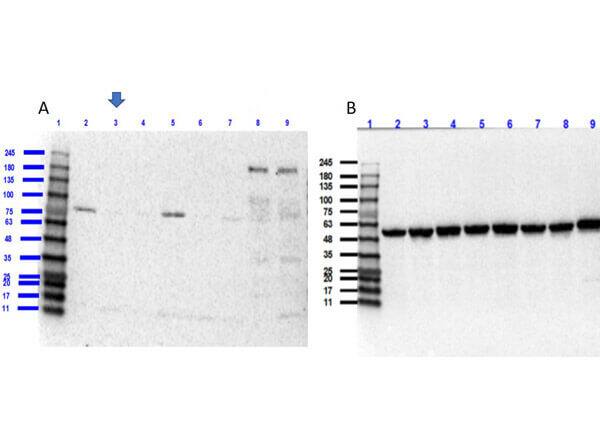ROBO1 Knockout A549 Cell Lysate
Novus Biologicals, part of Bio-Techne | Catalog # NBP3-18631

Key Product Details
Species
Human
Applications
Chromatin Immunoprecipitation, ELISA, Immunoprecipitation, SDS-PAGE, Western Blot
Product Summary for ROBO1 Knockout A549 Cell Lysate
ROBO1 knockout A549 cells were grown in Dulbecco's medium supplemented with 10% fetal bovine serum. Cells were washed with PBS and then incubated on ice in modified RIPA buffer, containing 150 mM sodium chloride, 50 mM Tris HCl, pH 7.4, 1 mM EDTA, 1.0% NP-40, 0.5% sodium deoxycholic acid , 0.1% SDS and 0.01% (w/v) sodium azide to lyse the cells. Protein integrity was ensured using a cocktail of protease inhibitors with broad specificity for the inhibition of aspartic, cysteine, and serine proteases as well as aminopeptidases (0.1 mM AEBSF HCl, 0.08 uM Aprotinin, 5 uM Bestatin, 1.5 uM E-64, 2 uM Leupeptin Hemisulfate, 1 uM Pepstatin A). Phosphatase inhibitors 1 mM NaF and 1 mM Na3VO4 were also added. Cell debris was removed by centrifugation. Protein concentration was determined by BCA using a commercially available kit. Protein concentration was adjusted to 2 mg/ml with modified 1X RIPA buffer. ROBO1 knockout A549 Clone 15 contains knockout deletions on all three copies of the ROBO1 gene in A549 cells. Each copy contains the same 23bp deletion induced by CRISPR/Cas 9. The deletion occurs in exon 2 and disrupts the sequence encoding amino acids 62 through 69, causing the downstream amino acid sequences to shift out of frame resulting in early stop codons. Validated by Sanger sequencing and Western blot.
Clone 15
Lysate Fractionation: Whole Cell Lysate
Lysate Stimulation: Not Stimulated
Culture Type: Tissue Culture
Clone 15
Lysate Fractionation: Whole Cell Lysate
Lysate Stimulation: Not Stimulated
Culture Type: Tissue Culture
Product Specifications
Application Notes
This product has been tested by SDS-PAGE and western blot and is suitable for use in Western blot, ELISA, Immunoprecipitation and ChIP. No detection of expected band at ~181kDa is observed in ROBO1 knockout A549 when compared with unmodified A549 cell lysates by Western blot.
Type
Knockout A549 Cell
Life Stage
Adult
Subcellular Fraction
Whole
Scientific Data Images for ROBO1 Knockout A549 Cell Lysate
Western Blot: ROBO1 Knockout A549 Cell Lysate [NBP3-18631]
Western Blot: ROBO1 Knockout A549 Cell Lysate [NBP3-18631] - Lane 1: Opal Prestained MW Marker. Lane 2: A549 ROBO KO Clone 5. Lane 3: A549 ROBO KO Clone 15. Lane 4: A549 ROBO KO Clone 17. Lane 5: A549 ROBO KO Clone 18. Lane 6: A549 ROBO KO Clone 21. Lane 7: A549 ROBO1 KO Bulk. Lane 8: A549 WCL Parental. Lane 9: MCF-7 WCL. Load: 35ug lysate/lane. Primary Antibody [Blot A] Anti-ROBO1 ~181kDa; [Blot B] stripped and re-probed with Anti-Tubulin ~50kDa; at 1ug/mL overnight at 2-8C. Secondary Antibody: Goat Anti-Rabbit IgG HRP at 1:70,000 for 30min at RT. Block: TTBS/Casein at RT. No detection of expected band at ~181kDa is observed in ROBO1 knockout A549 when compared with unmodified A549 cell lysates by Western blot.ROBO1 Knockout A549 Cell Lysate
Western Blot of ROBO1 Knockout A549 Cell Lysate. Lane 1: Opal Prestained MW MarkerFormulation, Preparation, and Storage
Preparation Method
ROBO1 knockout A549 cells were grown in Dulbecco's medium supplemented with 10% fetal bovine serum. Cells were washed with PBS and then incubated on ice in modified RIPA buffer, containing 150 mM sodium chloride, 50 mM Tris HCl, pH 7.4, 1 mM EDTA, 1.0% NP-40, 0.5% sodium deoxycholic acid , 0.1% SDS and 0.01% (w/v) sodium azide to lyse the cells. Protein integrity was ensured using a cocktail of protease inhibitors with broad specificity for the inhibition of aspartic, cysteine, and serine proteases as well as aminopeptidases (0.1 mM AEBSF HCl, 0.08 uM Aprotinin, 5 uM Bestatin, 1.5 uM E-64, 2 uM Leupeptin Hemisulfate, 1 uM Pepstatin A). Phosphatase inhibitors 1 mM NaF and 1 mM Na3VO4 were also added. Cell debris was removed by centrifugation. Protein concentration was determined by BCA using a commercially available kit. Protein concentration was adjusted to 2 mg/ml with modified 1X RIPA buffer.
ROBO1 knockout A549 Clone 15 contains knockout deletions on all three copies of the ROBO1 gene in A549 cells. Each copy contains the same 23bp deletion induced by CRISPR/Cas 9. The deletion occurs in exon 2 and disrupts the sequence encoding amino acids 62 through 69, causing the downstream amino acid sequences to shift out of frame resulting in early stop codons. Validated by Sanger sequencing and Western blot.
Purification
Multi-step
Formulation
1X RIPA Buffer with HALT Protease and Phosphatase Inhibitors
Preservative
No Preservative
Concentration
mg/ml
Shipping
The product is shipped with dry ice or equivalent. Upon receipt, store it immediately at the temperature recommended below.
Storage
Store at -70C. Avoid freeze-thaw cycles.
Background: ROBO1
Additional ROBO1 Products
Product Documents for ROBO1 Knockout A549 Cell Lysate
Product Specific Notices for ROBO1 Knockout A549 Cell Lysate
This product is for research use only and is not approved for use in humans or in clinical diagnosis. Lysates are guaranteed for 6 months from date of receipt.
Loading...
Loading...
Loading...
Loading...

![Western Blot: ROBO1 Knockout A549 Cell Lysate [NBP3-18631] Western Blot: ROBO1 Knockout A549 Cell Lysate [NBP3-18631]](https://resources.bio-techne.com/images/products/ROBO1-Knockout-A549-Cell-Lysate-Western-Blot-NBP3-18631-img0001.jpg)